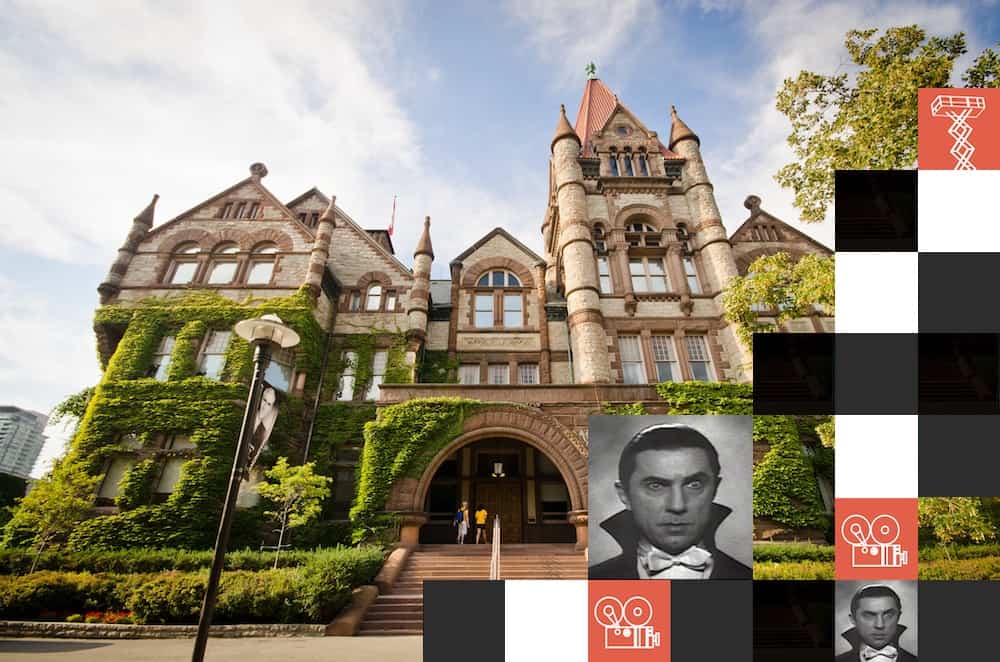There are few cinematic thrills to equal seeing part of your town getting blown up on the big screen. We’ve all been there. And if you’re enrolled at the University of Toronto, you’ve probably seen American film crews riding around campus, hogging our narrow side-streets with trucks and trailers. If you moved in early, you may have noticed the setup for an upcoming feature, The Mortal Instruments: City of Bones, the film adaptation of the popular young adult fantasy novel by Cassandra Clare. But this intrusion onto U of T’s campus is only the latest chapter in a rich history of film and TV crews drawing on U of T’s scenery for a touch of atmosphere, whether it’s academic or gothic.
The Mortal Instruments follows teenagers, demons, werewolves, and vampires as they clash across New York City, but the lines of trailers that occasionally stopped on Huron Street looked significantly less supernatural. The film would have been a great starting point for our foray into the nitty gritty of campus filming, but we quickly learned that Hollywood style snobbery follows film sets everywhere. Public relations shut down any attempts to talk to the cast and crew squatting in our very own backyard, claiming that they would not be doing any press for the film for some time. No matter, secretive PR heads were no match for young devotees of the series: gaggles of girls congregated in front of Knox College daily with copies of the novel shaking excitedly in their sweaty palms. They obsessively followed Twitter hashtags and fan pages to track the coordinates of each shooting location and the whereabouts of the cast.
It’s not hard to see why directors might want to utilize the old world gothic or classically collegiate look of the campus, but what is the appeal for viewers?
“I do find movies and television series filmed on campus to be more appealing. There’s something addicting about seeing a familiar location on screen,” said recent cinema studies graduate Brad Brisco. “My first year residence was at 89 Chestnut, which you can see explode with Toronto City Hall in Resident Evil: Apocalypse (2004). It sometimes felt very appropriate that Robarts Library stands in as a prison in Resident Evil: Afterlife (2010).”
Brisco also weighed in on the lack of recognition afforded to U of T’s campus in the majority of films shot on campus grounds.
“I have seen many films that use U of T’s campus as a backdrop. Unfortunately most times it follows the standard ‘Toronto as [city] format.’ We rarely get to see U of T represented as U of T.” TV shows also rely on Toronto for anonymous cityscapes. Thriller series Nikita and Covert Affairs both frequently film on campus despite by being set in America.
Our frat and sorority houses have also received attention from production companies, though often with their true identities obscured. The Beta House (a fraternity based north of Bloor on Huron) was prominently featured in Scott Pilgrim vs. the World (2010). In 2009 a house party was shot in the dingy space that usually houses Beta’s twenty-two members — all relocated for the three days of shooting. Where the rental fees for the fraternity space went is still up in the air, but Brisco recalls a subsequent controversy quite well.
“There was an incident in 2010 when Toronto City Council denied filming permits to seven U of T fraternities north of St. George and Bloor due to noise complaints. It was believed that these fraternities would make money from renting their house out for film and television production, and then use the money for a big house party.”
The truth behind the rumour never quite surfaced, but the city’s film commissioner was suspicious enough that filming was halted.
Fortunately U of T’s film resources are not on exclusive reserve for big production companies in search of Ivy League look-alikes. Even beyond the cinema studies program, the university offers students numerous opportunities to flex their creative muscles and reinterpret their surroundings like industry heavyweights.
The Hart House Film Board is a great pit stop for students flowing with ideas but low on funds or formal training. This film and production club provides members with access to equipment rentals, grants, workshops spanning storytelling to hands-on shooting, and even screening opportunities through U of T’s annual film festival. Most of the Film Board’s cameras are the latest digital models, but it also rents out Super 8 cameras, an easy-to-use format that harks back to the beginnings of independent film.
The lack of any unified cinematic identity for U of T should only serve as more impetus to make use of these support systems. Amateurs can follow in the footsteps of almuni directors such as Norman Jewison, David Cronenberg, and Atom Egoyan — none whom actually majored in film.
Still, the brief onscreen glimpses of U of T’s campus continue to resonate with students and locals alike. Brisco pointed to his favourite film from way back, when keeping details of the set location on the down low was still standard procedure.
“My favourite film shot at U of T also happens to be set at U of T. Sort of. In the Christmas-horror classic Black Christmas (1974), it is very clear that the film takes place in Toronto, but I do not believe it is verbally confirmed to be Toronto in the film. That was common practice in the 70s – be as ambiguous as possible as to where your Canadian film takes place in order to be able to sell the US distribution rights.”


